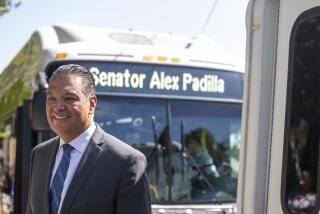Pay-to-Drive Plan Considered as Possible Route to Cleaner Air
- Share via
Everyone knows about pay-to-view television, but few have considered pay-to-drive freeways.
Some San Diego Assn. of Governments executives believe that may be the cash cow that will finance stiff new regulatory measures aimed at cutting down traffic congestion and improving air quality in San Diego County.
Sandag directors, most of them elected officials from the county’s 18 cities, had little positive to say about their regional agency’s program to control smog through discouraging solo commuters when the plan was reviewed for them last week.
What particularly raised their hackles was a staff member’s statement that a good share of the cost should be borne by developer’s impact fees on new construction.
John Duve, head of the Sandag traffic management program, explained that the development impact fees were proposed because “much of the cause of future (traffic) congestion will be new growth.”
But several Sandag directors thought that funds for the traffic management program should come from the driving public and suggested several methods to institute a pay-to-drive system, including toll roads, automated pay booths at freeway on-ramps, higher gasoline taxes, a system based on driven miles, or even taxing the second, third and fourth car in a family at an increasing rate.
San Marcos Mayor Lee Thibadeau favored the pay-per-mile system, even though it will cost him dearly if it is instituted because he drives more than 60,000 miles a year.
“I think it’s fair for me to have to pay more than someone who only drives 12,000 miles a year,” Thibadeau said.
Duve explained that the pay-to-drive ideas could not be considered by Sandag because such a financing system would require action by state agencies and in some cases require state legislation.
Solutions and financing must be within the powers of local governments, he explained.
The plan does contain one fee aimed directly at the driver, he said. The present $2 per vehicle fee tacked on to annual vehicle registrations will have to be increased to $20 by the turn of the century to support a portion of the traffic management program, he estimated.
Whatever the source of the finances, the Sandag traffic program will change the life of every driver in the county over the next decade, Sandag officials agree.
It also will hit the pocketbooks of many San Diego employers who must implement a $192-million program of van-pooling, bus fare subsidies, work-at-home programs and dozens of other methods to keep employees off the county’s roads.
San Diego Councilwoman Judy McCarty was among the dissenters to many of the Sandag-proposed traffic control measures and the costly bureaucracy required to run a program designed to produce cleaner air and freer freeways.
“What will happen when we achieve our (clean air) goals? Will they tell us?” she asked. “We’re going to give them $100 million, so they are not ever going to tell us we have clean air. We wouldn’t need them then,” she said of the organization required to implement traffic control measures.
Several Sandag directors favored incentives over disincentives as the answer to coaxing solo drivers out of their automobiles. Give them alternatives they can use--better bus service, more trains and trolleys, cleaner-burning fuels to allow the commuters to get where they are going without polluting and congesting.
After all their grumbling and criticism, the board approved the program with the proviso that they could take another look at changing it before the July 1 deadline when it must be approved by the local Air Pollution Control District board and sent to the state Air Resources Board.
The plan calls for expansion of the mass-transit system, conversion to low-emission buses, additional park-and-ride lots, more commuter lanes restricted to cars with two or more occupants, restricted truck traffic during peak commuting hours, better traffic light synchronization and other methods to smooth traffic flow and lessen traffic congestion.
More to Read
Sign up for Essential California
The most important California stories and recommendations in your inbox every morning.
You may occasionally receive promotional content from the Los Angeles Times.













